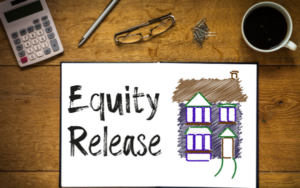
Many homeowners have benefitted from house price growth in recent years and it presents an interesting opportunity for many to use equity release to free up some of the money locked in their property.
So far in 2021, £1.14bn of housing wealth has already been released, according to the Equity Release Council.
According to SunLife, the average homeowner aged 55 and over – the point at which you can access equity release products – has lived in their current home for 24 years, during which time it is likely to have more than tripled in value. Many will have paid off their mortgage or may only have a small amount left, and on average could have £280,000 of equity in their property.
Here is how to release equity from your property.
What is equity release and how does it work?
Equity release is a financial product used by older homeowners to release cash locked up in their home, which is tax-free on withdrawal. It is only available for those aged over 55 (and older in some cases). Traditionally it has been used as an alternative or accompaniment to retirement income or to help pay off interest-only mortgages. But rising house prices mean homeowners are increasingly looking at how to release equity from their home for other reasons, such as helping their loved ones onto the property ladder or even purchasing another property for themselves.
There are two types of equity release scheme - a lifetime mortgage and a home reversion plan.
Lifetime mortgage
A lifetime mortgage is a specialist mortgage secured on your main residence. Unlike using a remortgage to release equity from your home, there are no monthly repayments and equity release providers roll up the loan amount and accrued interest to be paid back when you die or move into a care home. You will still own the property but once you pass away your family usually has to sell it to repay the full loan amount and any interest. This can impact any inheritance you may want to leave, although some plans will let you reserve a portion of the property value to pass on. Some providers will let you make contributions if you wish, but it also means the longer you live the more there will be to repay. You will typically be able to borrow up to 60 percent of the value of your property but this will depend on your age as well as your health. Similar to an enhanced annuity, if you have certain health conditions you could get a bigger equity release loan.
Home reversion plan
Another option to release equity from your property is home reversion plans. These typically have an older minimum age of 60 or 65. This product lets you sell some or all of your home to a home reversion provider in return for a lump sum or regular payments. You can typically receive between 20% and 60% of the market value of your home. You can still live in the property but must keep it well maintained as it could be subject to inspections and will need to meet certain conditions. Similar to a lifetime mortgage, the plan ends once you move into a care home or die and the property will be sold to repay the money that was released. You can also 'ringfence' some of the proceeds of the sale to leave as an inheritance.
What’s the difference between a remortgage and equity release?
The first port of call for many homeowners when looking to release equity for home improvements, or to just access cash locked up in their property, is to consider a remortgage.
Applying for a remortgage to release equity is a popular route to unlocking funds but it can be more difficult for older homeowners due to lending criteria among banks and building societies. Many lenders won’t lend into retirement, so if you are in your mid-60s or older it can be hard to remortgage to release equity, especially as lenders have introduced strict affordability criteria and interest rate stress tests for all borrowers. That's where equity release comes in - the minimum age is 55 so the product is deliberately geared towards older homeowners. Although, there is an issue therein; you may not have much of a mortgage left to repay and your income may be lower in retirement, so it could be harder to afford a remortgage plan just to release funds.
In contrast, you don’t have to make any monthly repayments with equity release, as everything is repaid once you pass away - usually through the sale of your property. The process of getting an equity release loan can be more flexible than a remortgage. There's no need for a gruelling mortgage interview while the approach to credit checks is slightly different. Your credit history is important when it comes to a mortgage as it gives an indication of how well you can afford repayments, but equity release providers can be more flexible. They are more concerned about the value of the property, so can be more understanding about county court judgements and bankruptcies that would cause many mortgage lenders to steer clear.
How to buy a second property using equity release
There are plenty of ways to use money drawn down from equity release. You could use the funds to help children or grandchildren with a deposit to get on the property ladder, to pay off your own mortgage, or just to supplement your own retirement income. Another option could be, if your house value has grown enough, to release equity from your home to buy another. You could then build a buy-to-let empire or finally purchase that holiday home you have always dreamed of. Equity release providers usually have their own maximum loan-to-value that is linked to your age, health and lifestyle, so you need to check this before committing to buying another property.
The first step when accessing equity release is for a provider to instruct a surveyor to value your home. This will determine how much equity you can release from your property. If you were remortgaging, a bank would then look at the size of your existing mortgage and your income and expenditure to decide how much you can afford for your monthly repayments. But, an equity release provider is mainly concerned about the property value, as they will only be repaid once you pass away or go into a care home when the sale of the property should cover any interest and repayments owed.
You then need to consider how much you actually want to release so you can cover the cost of the property purchase as well as any transaction costs such as legal fees, stamp duty, plus any lettings agent or property maintenance fees. Remember though, the bigger the loan you take out, the more interest you will have to pay so it is only worth releasing what you need or using providers that let you withdraw funds in portions.
Things to consider before using equity release schemes
Accessing the money in your property tax-free may make you assume that equity release is a good idea, but there are some pitfalls to look out for. The interest rates and fees associated with equity release can be more expensive than a traditional remortgage. You are also giving up a portion of what could have been your loved one’s inheritance.
This is a big financial decision which can be hard to undo, so it is important to seek specialist advice from financial advisers with specific equity release permissions. You can check this through the FCA register or by selecting an adviser through industry self-regulatory body, the Equity Release Council website. You can also find a qualified mortgage adviser near you that specialises in equity release by using the Vouchedfor service. Vouchedfor provides the UK's largest and most rigorous adviser search, ensuring all listed advisers are FCA-registered. Simply enter your town or postcode and select mortgage "Mortgage Adviser" from the initial dropdown. Once your search results are returned, click the "view more services" link and you can then filter the results on those advisers near you that offer equity release services.
Equity release can affect certain means-tested benefits, such as council tax exemptions or pension credit, which is another reason it is important to seek financial advice so all your circumstances are taken into account. There are certain standards set by the Equity Release Council that all providers must follow. They should provide a “no negative equity guarantee” so that when the property is sold - even if the amount left after agent or legal fees is not enough to repay the outstanding loan - neither you nor your estate will be liable to pay any more. You should also check that you have the right to move to another property and to transfer the debt, subject to it meeting the provider’s criteria.
An advantage of equity release schemes is that there is nothing to repay until you die or move into a care home. However, some providers will let you make monthly repayments rather than letting it all be rolled up into the end of the loan. This can reduce the monthly amount owed, but may result in your income being assessed as part of the application so you have to be sure you can afford it. You need to watch out for early repayment charges though as these can be steep and there are usually limits on how much you can repay each year.
Some providers will also let you withdraw funds in tranches rather than in one go. This can be beneficial, as the interest is charged on what you actually release, so it is worth checking if you can drawdown funds in small amounts so you don’t end up paying interest on funds you don’t actually need.
More equity release information
For an in-depth explanation of what equity release is, visit our article "What is equity release and how does it work? – Equity release mortgages explained", or listen to Podcast Episode 88 for an equity release alternative.





